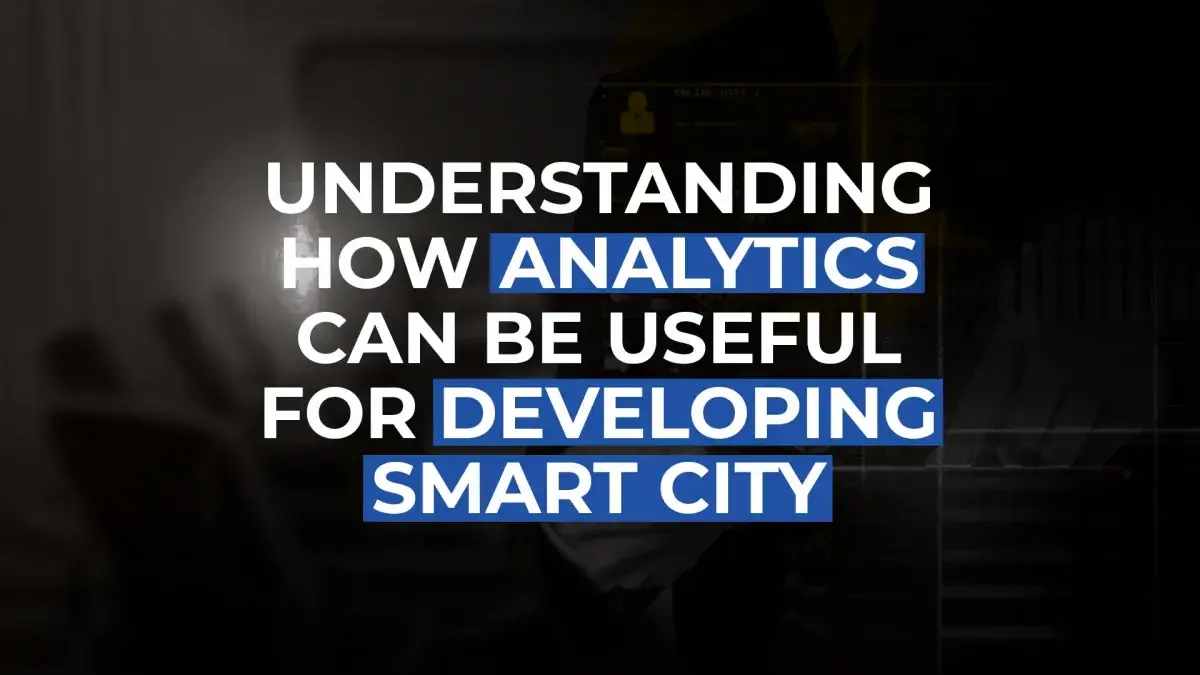The Role Data Analysts Play in Smart City Development

Here's What We've Covered!
With recent developments in technologies such as the Internet of Things (IoT) and Machine Learning, smart cities have started becoming a reality. Per the UN, around 68% of the world’s population will live in urban cities by 2050. This metric has also increased the incentive to push for the development of smart cities. One of the key technologies that go unnoticed in the development of smart cities is big data analytics.
Thanks to the increased consumer data available on the internet, businesses and government bodies working towards the development of smart cities have reliable insights to help them develop smart cities that increase the quality of life for their citizens. If you’re thinking of pursuing a data analytics course, you will have several opportunities to work in smart city development.
Before we dive into these opportunities, let’s first explore what a smart city is and how it comes together.
What is a Smart City?
Smart cities are municipalities that are able to fully utilize their IT infrastructure to benefit the quality of life of their citizens. While there isn’t an official definition coined for smart cities as of now, there are several characteristics that can help determine if a city is a smart city. These are:
- Technological infrastructure
- Interconnected sensors and actuators for various municipal purposes
- Unified database for citizens to access
- Environmental initiatives
- Superior urban planning
- Efficient public transportation system
There are several other intricacies that help develop a smart city; however, the above characteristics are always common in all smart cities across the globe.
What Makes a Smart City?
When discussing the IT infrastructure that helps make a smart city, we can’t help but mention the Internet of Things (IoT) and Data Analytics. In general, the success of a smart city depends on the relationship between its government and private sector firms.
When there is perfect harmony between both sectors, the city can develop a data-driven environment for driving progress in every field possible. The collaboration forms an independent system which is built on collaboration instead of competition. There are three factors involved in smart cities today:
1. Technological Layer
The technological layer includes everything from the cloud to the physical sensors and actuators working together to form a smart city. All the “things” mentioned here remain connected with each other to form the citywide IoT network.
2. Dedicated Applications
Everything from law enforcement to power grids should have their dedicated applications with citywide compatibility. Even if different firms work on these applications, they must be able to create a system that is seamless and has no barriers to innovation.
3. Application Usage
The applications that have been designed must be implemented in a way that they are accessible to all citizens. They should have an intuitive interface that does not limit access only to the technologically literate folk present in the city.
How is Big Data Analytics Used in the Development of Smart Cities?
As you can see, smart cities require data analytics in order to function well. The development of various sectors in a smart city depends on the data that is collected using sensors and then used to either generate insights or train models to automate processes.
In the case of automation, the developers would need to collect large volumes of specific data, clean it, and use it to train machine learning or deep learning models for the purpose of automating certain tasks.
An instance of this can be observed in the case of smart electronics that shut themselves off when the power grid notifies them of a potential increase in electricity rates.
However, when talking about decision-making at the bureaucratic level, the decisions in smart cities are made using insights generated from the data. Data analysts would interpret the data to judge factors such as public opinion, citizen behaviour, crime reports, and more to make meaningful insights that would help the government improve the lives of the citizens.
How to Become a Data Analyst?
Becoming a data analyst isn’t as hard as some people make it out to be. In fact, you may not even need a college degree in data science to start out as an entry-level data analyst. In this field, what matters more than formal education is the skills you can showcase to your recruiters. Here’s an optimized pathway to get you started:
- Take a course to build your foundation
- Build your technical skills
- Start working on projects with actual data
- Develop your portfolio and post it on GitHub and LinkedIn
- Apply for certification
- Get an entry-level job
With this process, you would become a data analyst, and it wouldn’t even require a traditional degree in the field.
The Best Course to Become a Data Analyst
If you’re on the lookout for excellent courses on data analytics, perhaps the PGCM in Data Analytics offered by IMS Proschool can give you the start you need. The course is made with the help of industry professionals and is designed to help build your industry-ready skills in the field.
The program helps you complete your specialization in one year instead of the usual two years and prepares you for the workforce early on in your career. Their batches start twice every year and they also offer online learning solutions for students who can’t physically attend the institution.
Applications of Big Data Analytics in Smart Cities
Once you work in data analytics, here are some applications where you may be able to apply your skills:
- Public Safety and Law Enforcement
As mentioned earlier, predictive analysis can be used to review critical crime-related data and predict where crimes are likely to occur. The insights generated from the data here are able to help make the city a much safer place to live in.
- Transportation
With big data analytics, public transport can be optimized to make transits as short as possible. Data analysts can investigate trends in city data that can help reduce traffic congestion and also assist authorities in developing smarter ways to manage the traffic in the city.
- Cost Reduction in Various Sectors
With various improvements being made in various sectors, the city can reduce the costs needed to run things. This money can then be used for other causes that would further benefit the quality of life of the citizens.
- Sustainable Growth and Pollution Control
Sustainable growth has become an important factor in urban planning today. With data analytics, the outcomes of city developments on the environment can be measured before they are implemented. This would help reduce unnecessary pollution and help preserve the environment.
- Smart Grids
Smart grids are another essential example of smart city technologies that require data analytics to function. Smart electric grids use data from homes to predict phases of high and low demand. This would help them optimize energy consumption and costs for the citizens.
Final Thoughts
The smart city industry is bound to boom at a rapid pace in the coming years. If you are able to establish yourself as a successful data analyst, your scope in the industry will be limitless. Join IMS Proschool today and explore the possibilities that await you.
FAQs
What is IoT in Smart Cities?
IoT refers to the Internet of Things, which is a technology allowing smart devices to interact with each other similar to how the internet allows computers to interact with each other.
Is Privacy Affected by Smart Cities?
Privacy is one of the biggest concerns citizens have when living in a smart city. However, thanks to the security infrastructure, citizen data is maintained private.
Which are the Most Important Components of a Smart City?
Some of the most important components of smart cities are the technologies used and the data that helps authorities make better decisions.
Resent Post
>
Emerging commerce career options in India (2026): From CA to Data Analyst
>
ACCA Opportunities You Didn’t Know About – Think Beyond Audit!
>
Which Courses After 12th Commerce With High Salary Are in Demand Worldwide?
>
How to Find ACCA Jobs Online After Qualifying: Real Portals, Tips & Career Guidance
>
Financial Modelling Classes in Hyderabad: Your Guide to the Best Institutes
Follow Us For All Updates!





